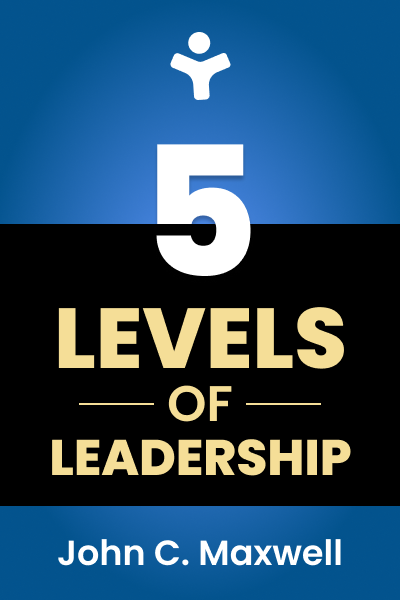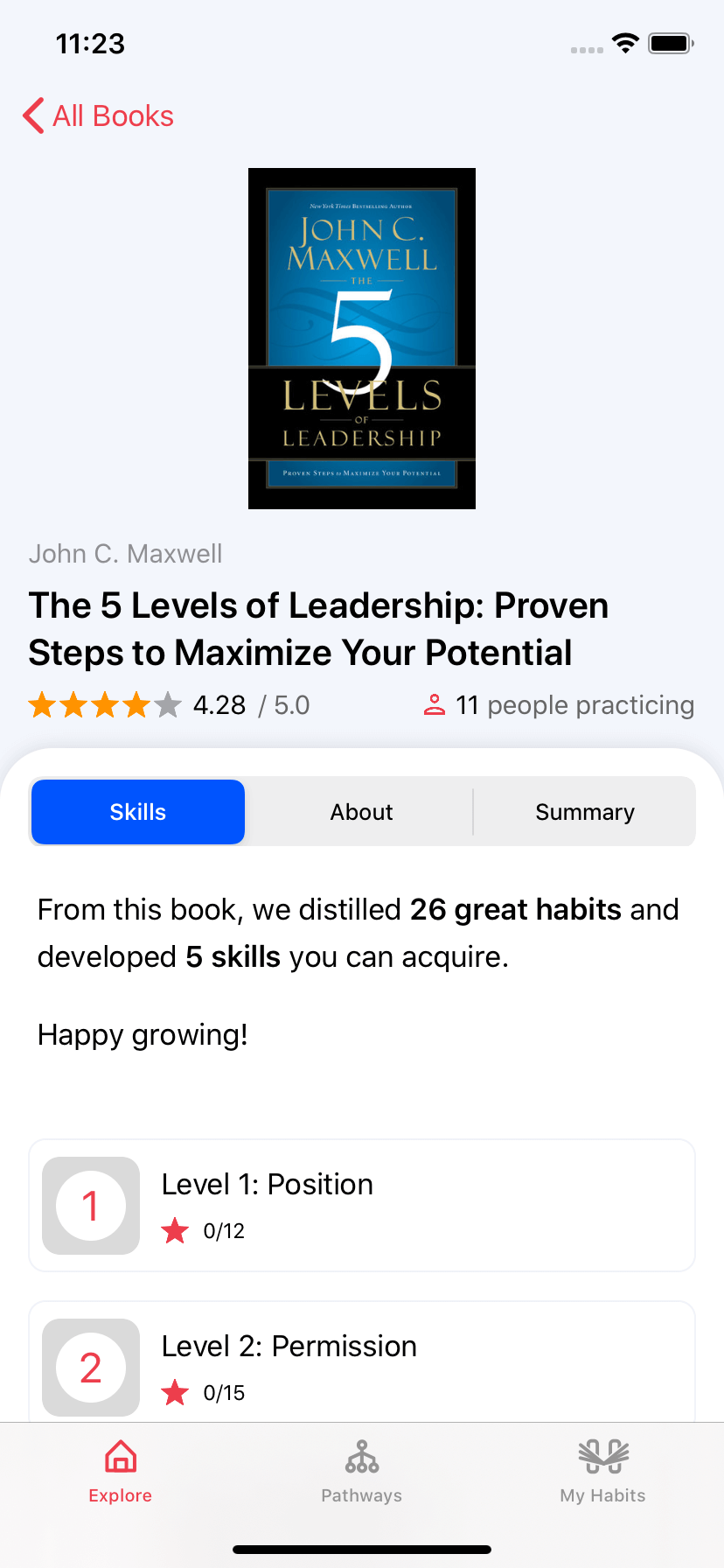
The 5 Levels of Leadership: Proven Steps to Maximize Your Potential
Read in the App
Full actionable summary
Did you ever consider what it takes to be a great leader? What is required to improve your leadership skills and become like Jack Welch from General Electric? It is possible to become a leader due to a situation. In this case, you are likely on level 1—the Position Leader. People follow you because they have to. It's a good place to start; however, it’s not where you want to stay.
This book provides a complete formula to become a leader that everyone wants to follow. A leader that is well recognized and very respected among other organizations.
What You'll Learn
This summary distills the key insights from The 5 Levels of Leadership: Proven Steps to Maximize Your Potential into actionable steps you can apply immediately. Perfect for busy professionals who want to learn and implement quickly.
Read in the App
Get the full actionable summary with our mobile app
Key Insights & Chapters
You can have a leadership game plan for your life
“Leadership is much less about what you do and much more about who you are.” - Frances Hesselbein
The first and most important thing to know about leadership is that it’s not a position. It’s a process. Being a manager is a position; leadership is different—it’s the relationship between people. The challenge of leadership is to create change and facilitate growth.
And remember, leadership is not about advancing yourself. It is about advancing your team.
Actions to Take
Overview of the 5 Levels of Leadership
There are 5 levels of leadership, and each level is very distinct from the others:
-
Position: People follow you because they have to.
-
Permission: People follow you because they want to.
-
Production: People follow you because of what you’ve done for the organization.
-
People development: People follow you because of what you’ve done for them.
-
Pinnacle: People follow you because of who you are and what you represent.
Here are some important things to know about these 5 levels:
- You are not on the same level with every person. With every person, you have to build your position from the beginning.
- The higher you go, the easier it is to lead.
- The higher you go, the more time and commitment is required to win a level.
- Moving up levels occurs slowly, but going down can happen quickly.
- The higher you go, the greater the return.
- Not climbing the levels limits you and your people.
- When you change positions or organizations, you seldom stay at the same level. However, it’s much easier to climb because you know how to do it.
- You cannot climb the levels alone.
Actions to Take
Level 1: Position
“It’s a great place to visit, but you wouldn’t want to live there”
Position leaders are leaders because of their situation. People follow you because they have to, not because they want to. Everyone who has been nominated as a leader of a team is here. If you become a leader, it’s because you have the potential. But it doesn’t mean that people will follow you and you will stay there.
Even though leaders on level 1 are nominated, there are a bunch of things that you can do to strengthen your position and prepare for the next level.
There are three key principles that determine effective leadership at this level:
-
Leadership ability determines a person’s level of effectiveness.
We are not equally gifted, and we must grow and develop ourselves to reach our fullest leadership potential. -
Leadership develops daily, but not in a single day.
As we said before, being a leader is not about simply gaining the position. It’s a lifelong process of leadership skill development. -
Anyone can steer the ship, but it takes a leader to chart the course.
Recognize where you are in your leadership journey. You might already be a leader, but consider how much you have to learn to move to the next level.
Actions to Take
Level 2: Permission
“You can’t lead people until you like people”
Leadership is about influence, and you cannot truly influence people if you depend on your position. That’s why moving to level 2, permission, is the first step to becoming a real leader.
Level 2 leaders make the workplace more enjoyable. This is because they are more focused on people instead of themselves. They move from “me” to “we”. It’s a mistake to only care about your position and your career advancement. Good leaders want other people on the team to succeed.
Leadership permission increases the energy level within the team because people like to spend time with each other. It opens up channels for communication. Instead of having a top-down relationship, you have a side-by-side relationship.
However, there is a real risk that permissional leadership can become manipulative as there is a thin line between motivation and manipulation. Remember the golden rule: treat others as you would like to be treated.
Permissional leadership is about the relationship; however, you should never put building great community over the contribution to the organization. At the end of the day, the company is not like a family. Yes, it is about people, but you still should require responsibility and accountability from your people in order for the organization to function effectively. To do this, you want to strike a balance between care and candor:
-
Caring values the person, while Candor values the person’s potential.
-
Caring establishes the relationship, while Candor expands the relationship.
-
Caring defines the relationship, while Candor directs the relationship.
-
Caring should never suppress candor, while Candor should never displace caring.
Actions to Take
Level 3: Production
“Making things happen separates real leaders from wannabes”
Leaders on level 3 are those who produce results for the organization. They are productive individually, and they also help the team to produce. Productive leaders attract other productive people. They have respect for each other and help the organization to grow.
High production gives these leaders confidence, credibility, and increased influence.
High production leaders set the standard for others visually. They deliver results. They lead by example.
Level 3 leaders communicate the vision of the company through action. People see goals being met and get a clearer picture of what it means to fulfill the vision. Not clearly defining the vision leads to fuzzy communication and sloppy execution. Having a clearly defined vision is an integral part of leadership. Leaders create the link between the vision of the organization and the everyday production of the team. They show how daily work impacts the whole vision.
Production leaders don’t leave solving problems for someone else. They are active in breaking through the obstacles, putting out fires, correcting mistakes, and directing people.
And finally, production leaders create momentum. Without momentum, everything is harder to do than it seems. Momentum helps leaders to do things more easily.
Actions to Take
Level 4: People Development
“Helping individual leaders grow extends your influence and impact”
Climbing through each level of the 5 levels of leadership requires a paradigm shift. On each level, there is a different way of thinking as a leader.
On level 4, you should put more emphasis on the development of people (not neglecting other levels). You must transition from the producer to the developer. You must invest your time, energy, money and thinking into growing others as leaders. There are five steps involved in developing someone else:
-
I do it (competence).
-
I do it and you are with me (demonstration).
-
You do it and I am with you (coaching).
-
You do it (empowerment).
-
You do it and someone is with you (reproduction).
Leaders on level 4 shift their focus from production achieved by others to the development of their potential. They are no longer focused so much on productivity but on the personal development of other leaders.
Only leaders can develop other people to become leaders. People who have no experience in leadership cannot develop leaders.
Actions to Take
Level 5: The Pinnacle
“The highest leadership accomplishment is developing other leaders to level 4.”
Pinnacle leaders are the leaders who develop other leaders to level 4. It’s the highest level, and they are a real asset to their company. Reaching level 5 requires mastering the four levels that come before, and also some natural leadership skills.
Level 5 leaders are important to create level 5 organizations such as General Electric, where Jack Welch was a strong level 5 leader and created a legacy of leadership. The real test of level 5 leaders is whether they can create a legacy of leadership.
There is an old saying that you are the average of the five people closest to you. Having your inner circle will help you to reach your leadership potential, and take the organization to a higher level.
The other function of your inner circle is to keep you grounded. It’s very easy for leaders to begin believing their own reputation on Level 5. A good inner circle can help leaders at the pinnacle level avoid that pitfall. A good inner circle will allow leaders to be themselves, but inner circle members will also tell the truth about themselves.
This is what your inner circle should do for you:
- Love you unconditionally.
- Represent you according to your values.
- Watch your back.
- Complement your weaknesses.
- Continue to grow.
- Fulfill their responsibilities with excellence.
- Be honest with you.
- Tell you what you need to hear, not what you want to hear.
- Work together as a team.
- Enjoy the journey with you.
Actions to Take
Get Full Access in the App
Download Mentorist to explore detailed action steps, track your progress, and build lasting habits.

Experience the Full Summary
Read comprehensive summaries and track your progress with our mobile app